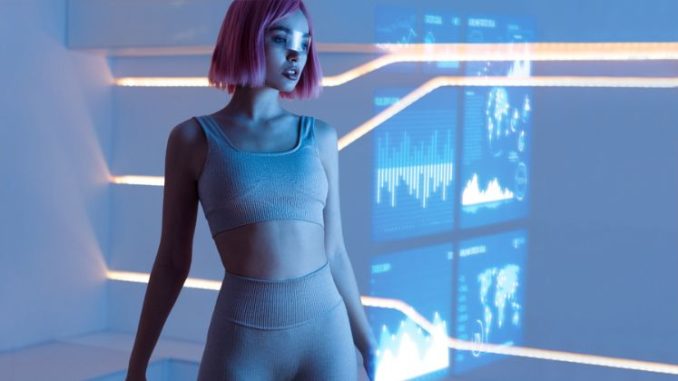
The advent of the metaverse/digital fashion has brought about significant transformation for businesses to generate revenue and engage customers in novel ways. What didn’t work well till 2021 or before, now seems to be a promising strategy from 2022-23 onwards as tech companies are setting up the platform for future so that brands and retailers can encash on the growing opportunities in the domain. Consider the following scenarios:
Scenario 1: Imagine yourself donning a T-shirt within the metaverse, made from a fabric impossible to replicate in the real world. On this T-shirt, flames move around your shoulders, bright lights shine on your sleeves and a message instantly appears on your chest! The question then arises: Wouldn’t you desire an expressive digital avatar that sets you apart in a virtual crowd?
Scenario 2: Picture a scene where users can virtually try on clothing through augmented reality, enabling them to visualise how a garment looks and fits without physically trying it on. This revolutionises the online shopping experience.
Scenario 3: Envisage accessories in the metaverse that dynamically change colours based on the user’s mood or preferences, allowing for a personalised and interactive fashion experience.
Scenario 4: Imagine attending a virtual fashion show within the metaverse, featuring holographic models showcasing the latest trends. Users can witness the runway from the comfort of their digital spaces.
These scenes exemplify the efforts of fashion enthusiasts today, dedicated to creating a space for fashion consumers and brands to transition into the realm of fashion ‘metaverse’. In this virtual world, they can immerse themselves in a digital existence that mirrors reality and offers interactivity and innovation.
Right from luxury brands (Burberry, Balenciaga, Gucci, Louis Vuitton) to premium brands (Ralph Lauren, Tommy Hilfiger, Nike) and even fast fashion brands (H&M, Zara), the fashion retail fraternity is affiliating strongly with the metaverse to mark a strong presence in this virtual domain. And rightly so as the global metaverse market size valued at US $ 100.27 billion in 2022 which is projected to grow to a whopping US $ 1.53 trillion by 2029, exhibiting an impressive CAGR of 47.60 per cent. Who doesn’t want to be a part of this massively mushrooming concept!
| While the concept of digital fashion originated from the video game industry, the fashion world embraced it with great creativity. In video games, users buy skins to make their characters unique and this idea has evolved. Fashion brands, viewing it as a revenue stream, began creating and selling virtual skins. |
Reasons behind the rising trend of virtual fashion
The rise of digital fashion serves as an essential supplement to the physical clothing industry which is driven by the profound desire of consumers for in-store retail experience. Digital fashion brands themselves are also witnessing the addition of new customers in an entirely different category.
The disruption caused by the pandemic prompted brands and retailers to explore alternative concepts, leading to the emergence of virtuality. Unable to sell physical goods throughout 2020 and in early 2021, brands sought ways to establish global presence without relying on traditional sales. This shift is rooted in ethical buying concepts, a notion gaining strong traction amongst the next generation of consumers. As this generation extensively immerses itself in the virtual realm, there is a belief that physical clothing may not align with their preferences, leading to an inclination towards investing in digital fashion wearables.
While the concept of digital fashion originated from the video game industry, the fashion world embraced it with great creativity. In video games, users buy skins to make their characters unique and this idea has evolved. Fashion brands, viewing it as a revenue stream, began creating and selling virtual skins.

“As technology advanced, more interactive games, immersive internet experiences and innovative digital products contributed to the rise of the ‘metaverse’. In the digital realm, the metaverse replicates aspects of the physical world, captivating the interest of fashion enthusiasts who appreciate this virtual landscape,” commented Sunil Arora, Co-Founder, Trace Network Labs.
Fashion Metaverse and India: Current state and projections
In October 2021, the idea of metaverse became a thing in India when the famous fashion designer Manish Malhotra teamed up with WazirX NFT Marketplace and FDCI x Lakme Fashion Week. They made five special digital fashion items, known as NFTs. Manish Malhotra was the first Indian designer to step into this virtual world.
Following him, Papa Don’t Preach, a popular fashion label in India, also jumped on to the metaverse bandwagon. It became the first fashion label in the country to display digital fashion in metaverse during a fashion show organised by the Women’s Economic Forum. The label showcased six of its pieces on the digital runway, letting people use these virtual designs for their online avatars.
Flipkart, a renowned e-commerce company in India, also entered the metaverse scene with its platform called Flipverse. It teamed up with over 15 brands, including PUMA, to create about 100 virtual products for the launch.
Dennison, a leading Indian D2C workwear apparel company, is set to make a groundbreaking entry into the metaverse through a partnership with Trace Network Labs. Recently Dennison India also debuted its brand store in the PARIZ Metaverse, marking a significant step towards merging the fashion and the digital world. The move leverages gaming, Web3 and AI to offer an immersive shopping experience. The collaboration, as per Ashwini Seth, Co-Founder and CEO of Dennison, aims to redefine the future of the fashion industry by seamlessly combining physical and digital elements.
Jack & Jones has also introduced a special collection in India inspired by the metaverse. This unique release aims to seamlessly blend technology and fashion, creating a crossover between the physical and virtual realms.
HE SPOKE – a digital-only fashion brand – has also started tapping digital users in India. Using advanced technology and a unique digital approach, the brand quickly reveals trends while caring for the environment.
Other famous designers like Raghavendra Rathore, Anamika Khanna and Pankaj & Nidhi are also exploring the metaverse, trying to make a big impact with their digital products.
However, these moves are considered small in a country with over 1.40 billion people and US $ 80-90 billion worth of apparel retail market size. Many challenges exist, especially because Indian society values touch and feel and shifting to a touchless approach is seen as a big psychological change, according to Raghavendra Rathore.
While many Indian brands are thinking about joining the metaverse, they’re struggling to figure out the return on investment. It’s still early days for Indian brands to foray into the metaverse! Some success has been seen in attracting the younger generation from social media to the metaverse, using technologies like Augmented Reality (AR). However, making metaverse avatars as good as the real thing will take more time and understandably so. The use of Try-Ons has been around for a while and now it’s time to bring physical and digital assets together in metaverse, which could be a game-changer.

“The challenges accompanying the nascent metaverse necessitate addressing issues like ensuring the capability of our computers to handle it. The advent of 5G, a faster technology, is poised to provide substantial assistance in this regard. However, there remain aspects that require further exploration, such as optimising metaverse usage on the internet. Presently, downloading appears to be more efficient, but efforts are underway to enhance functionality within web browsers,” commented Vikram R Singh, CEO, Antier Solutions.
How can a profitable and revenue-earning fashion brand be built on metaverse?
According to Statista, over 3.03 billion people reportedly said they played video games in 2022 and the average gamer spent more than eight hours a week on games! This is where the opportunity lies for the fashion retailers for symbiotic growth. Apart from gaming industry, the social media platforms such as Instagram and Facebook and apps such as Zepeto too are becoming a driving force for brands to earn more revenues in digital space.
As avatars within these new spaces – gaming, social media – need clothing to wear, they are providing brands with a fresh revenue stream and helping them make more money by selling their virtual items and clothing in this decentralised market.
For example, Roblox – a virtual gaming platform – reports that 25 million virtual items were created on its platform in 2021 alone. Almost 5.80 billion units of those were bought (both paid and free), earning creators US $ 538 million. Fashion brands such as Gucci, Ralph Lauren, Givenchy, Tommy Hilfiger and Nike amongst many others have already partnered with Roblox.
It is evident that discussions surrounding metaverse and Web3 have been widespread, yet there is absence of mainstream applications utilising these technologies.
Framework needed for fashion brands/retailers to successfully integrate metaverse concept in their stores!
The growing significance of the fashion metaverse is evident as retailers explore innovative methods to connect with customers and distinguish themselves in a competitive market. With discussions underway about incorporating the metaverse concept into bricks-and-mortar retail establishments to attract a broader consumer base, it is essential to understand the strategies for successful implementation!

According to Andy Ku, Co-Founder, ALTAVA – a fashion metaverse and digital wardrobe company – metaverse technology can assist fashion retailers in a number of ways in creating a more immersive and interesting shopping experience.
Virtual Try-Ons: Using augmented reality (AR) and virtual reality (VR) technology, metaverse technology enables customers to virtually try on apparel and accessories in real-time. Customers may get a better idea of how the item will look on them and returns may be decreased as a result.
Virtual Storefronts: Using VR technology, customers can explore and interact with virtual storefronts that fashion retailers can design using metaverse technology. These storefronts can be made to resemble the appearance and atmosphere of a real store, complete with digital racks and shelves for clothing and accessories.
Social Shopping: The technology allows customers to communicate with one another in real-time as they browse and purchase apparel and accessories. This may include elements like online chat rooms and group shopping opportunities.
Here are some steps that fashion retailers can take to ensure that metaverse integration in their stores is accessible and user-friendly for all customers:
Multiple entry points: Clothing stores ought to offer their customers a variety of ways to access the metaverse. This can include actual in-store kiosks or displays in addition to online portals accessed via computers or mobile devices.
Easy to navigate: Fashion retailers should make the metaverse experience simple to use and intuitive for users of all ages and technical proficiency. Clear instructions, uncomplicated interfaces and simple controls can help with this.
Providing support and training: Customers who might not be familiar with metaverse technology should receive support and training from fashion retailers. This can involve in-store assistance from knowledgeable staff as well as tutorials, displays and demonstrations.
Considering accessibility: Fashion retailers should think about accessibility features for customers with disabilities, including screen readers, audio descriptions and other assistive technologies.
Conducting user testing: To make sure that the metaverse experience is open to and user-friendly for everyone, fashion retailers should conduct user testing on a diverse group of customers.
The real question here is: Is size of retailers (luxury, premium, fast fashion) an issue while integrating metaverse concepts into physical retail stores?
When it comes to incorporating metaverse concepts into actual retail stores, the size of a retailer can play a role, but it is not necessarily a hindrance.
The ability to invest in metaverse technology and create a more immersive and engaging shopping experience may be more accessible to luxury and premium retailers. They might also operate fewer stores, simplifying the application of metaverse technology across all locations.
Retailers in the fast fashion sector may have a higher number of locations, posing challenges in uniformly implementing metaverse concepts throughout all outlets. Nevertheless, fast fashion retailers may possess greater agility, enabling them to swiftly adapt to evolving fashions and technologies.
“The success of metaverse integration into physical retail stores ultimately relies on various factors, including the retailer’s goals, customer requirements and preferences, as well as the accessibility and cost of the technology. If executed properly and thoughtfully, metaverse integration can be advantageous for both fast and high-end fashion retailers,” mentioned Andy.
Suggesting some framework, Vikram Singh said that the main recommendation is to connect making money with virtual worlds, like the metaverse. Currently, there’s a big gap between these two things because the industry hasn’t figured out a comprehensive plan. He averred, “Some programs and ideas show potential, but they don’t guide people in the right direction. That’s why it’s crucial to take things step by step.”
He further stated, “The challenge isn’t just knowing what customers want, but also getting them to embrace new and improved ways of doing things. Our goal is to provide strategic advice to brands, helping them find personalised solutions and reach their full potential. This includes creating user-friendly platforms that make it easy for brands to join the metaverse.”
The relationship between brands and customers is essential, similar to how social media works, where only a few entities profit from content. To address this, the brands need a three-part approach, as per Vikram.
“First, we must understand the major issues in society. Second, we should help fashion brands gradually become more visible online. Third, we need to design easy-to-use websites to make it simple for people to use our products. If we succeed, we can create a plan that a special group of customers can follow, making it easier to grow in the future,” he asserted.
| In the eyes of today’s generation, adopting humanised avatars has become a style statement, reflecting their desire to stand out in the virtual world. The primary emphasis of the fashion brands should be on providing authentic ‘wearability’ to fashion products on digital human avatars, as the essential quality of a garment is its suitability for wearing. The key question for brands or developers is whether the showcased garment in the metaverse is truly wearable! This approach is poised to become the distinctive fashion signature for individuals in any metaverse, regardless of the underlying blockchain. This is where companies like Trace Network, KiXR, Antier and others set themselves apart, emphasising the commitment to creating a meaningful impact in the evolving landscape. |
‘Community Building’ more rewarding than ‘Loyalty Program’ initiatives for revenue generation
In today’s world, most customer loyalty programs are not really about making customers stick around for a long time. They mostly try to get people to spend more money. Many fashion brands, for example, offer deals and call you a ‘loyal customer’ if you collect points. But to get this label, you have to do things like write a review, follow them on social media, or tell your friends about their products.
These tricks might get people to buy more, but they don’t necessarily create a community of dedicated and excited customers for a brand. True loyal customers come naturally, not because you asked them to be loyal. While having a big audience can help a brand sell more, having a community that really cares about the brand leads to customers who love and talk about the brand without being asked. Real loyalty is when customers feel a strong emotional connection, like they’re part of an exclusive group.
From a monetary perspective, it’s better for a brand to retain customers who already like them than to find a bunch of new customers. The idea that 80 per cent of the money comes from 20 per cent of the customers is a big part of why building a community is so important.
For example, if you’re crazy about sneakers, you probably always check out Nike for shoes. If you love a fast fashion brand like Uniqlo, you won’t look at other brands for your clothes. It’s interesting how strong communities are built around things like sports and activities and the next big thing might be sustainability and ethical practices.
Let’s look at how some fashion brands are building their communities:
| Consider the amount of pollution generated from clothing production – 2.8 billion tonnes of carbon emissions, with 70 per cent stemming from the manufacturing processes. Picture a scenario where individuals can input their body size while shopping. This data could assist fashion brands in understanding the sizes and styles most preferred by the majority. In India, numerous individuals find the need to alter their purchased clothes, such as jeans. Addressing this issue could contribute to a reduction in pollution and positively impact the planet. |
Gymshark: This fitness brand is growing fast because of its strong community. It has a platform called ‘Gymshark Central’ with articles about health and fitness. It also uses athletes with big social media followings to represent the brand and connect with fans.
Lululemon Athletica: Known for yoga and athleisure, Lululemon builds its community by encouraging customers to lead healthy lives. It even offers free yoga classes and events for its members.
Charlie Hustle: This brand creates a community around sports-themed T-shirts dedicated to places like Kansas City. Wearing its T-shirts makes you feel like you are part of a community. It also has a rewards program to keep people engaged.
Nike: A long-standing sports brand, Nike connects with its community through social media and its own social platform. It lets customers customise designs through an app and offer insights into what people like. Nike also has a digital space called the Nike Trainers Hub where members get access to top athletes’ training programs.
These brands show that building a real connection with a community is more valuable than just getting people to buy things. It’s about creating a group of customers who genuinely care about and support the brand.
NFT platforms offer strong connectivity to consumers with digital fashion
NFT platforms offer NFT-connected wearability options for digital fashion users. These options include purchasing items in digital form, physical form, or both, allowing users to evaluate the product digitally before deciding to acquire a physical replica. According to the metaverse enthusiasts, the versatility of this concept is great, catering to both B2C and B2B models. The companies are establishing shopping malls in the metaverse, featuring virtual showrooms and concept stores that integrate fashion, lifestyle and entertainment to enhance user experience.
For individual users, digital avatars and digital clothes function as NFTs, serving as passports for seamless transitions between different metaverses. During these transitions, certain information required by the metaverse is captured through NFTs, specifically from users’ faces. NFT-enabled wearables assure users of purchasing authentic products from genuine brands. This innovative approach aims to assist brands and designers in optimising the use of NFT concepts.
The process looks something like this – the users (consumers) provide brands or metaverse firms pictures that are used to develop avatars, and if liked, users can claim and store them as NFTs in their wallets – a procedure completed in just less than two minutes.


